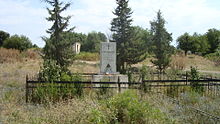Maraga massacre: Difference between revisions
See discussion for "US congress documents". Corrected the text according to HRW. |
multiple issues |
||
| Line 1: | Line 1: | ||
{{POV|December 2010}} |
|||
{{unreliable sources|December 2010}} |
|||
{{notability|December 2010}} |
|||
[[Image:MaragharMassacre.jpg|thumb|right|Azeri armored vehicles approaching Maraghar on April 10, 1992]] |
[[Image:MaragharMassacre.jpg|thumb|right|Azeri armored vehicles approaching Maraghar on April 10, 1992]] |
||
[[File:Nor Maragha004.JPG|thumb|right|A monument for victims in Maraghar Massacre. Nor Maragha village.]] |
[[File:Nor Maragha004.JPG|thumb|right|A monument for victims in Maraghar Massacre. Nor Maragha village.]] |
||
Revision as of 22:56, 20 December 2010
The neutrality of this article is disputed. |
Some of this December 2010's listed sources may not be reliable. |
The topic of this article may not meet Wikipedia's general notability guideline. |


The Maraghar Massacre was the April 10, 1992 killing of the ethnic Armenians during the capture of Maraga by Azerbaijani troops[1] during the Nagorno-Karabakh War. According to Human Rights Watch (Helsinki), the attack reportedly took 40 lives and several dozen hostages.[2]
The Massacre
According to Baroness Caroline Cox, who observed the damage and interviewed eyewitnesses, Azerbaijani forces attacked the Armenian town of Maragha, decapitated about forty five villagers, burned and looted much of the town, and kidnapped about one hundred women and children.[3] According to Helsinki Watch, Azerbaijani forces attacked Maragha on 10 April 1992 where most of the Armenian villagers left after they got word that their self-defense troops could not hold their posts. Civilians who remained in underground shelters, mainly elderly and disabled people,[4] were captured as hostages or murdered.[5][6] The inhabitants of Maragha who were driven out after the attack were unable to return to their village after the cease-fire of 1994, as the area was still under Azeri control.
“Maraghar: the name of this village is associated with a massacre which never reached the world’s headlines, although at least 45 Armenians died cruel deaths. During the CSI mission to Nagorno Karabakh in April, news came through that a village in the north, in Martakert region, had been overrun by Azeri-Turks on April 10 and there had been a number of civilians killed. A group went to obtain evidence and found a village with survivors in a state of shock, their burn-out homes still smoldering, charred remains of corpses and vertebrae still on the ground, where people had their heads sawn off, and their bodies burnt in front of their families. 45 people had been massacred and 100 were missing, possibly suffering a fate worse than death. In order to verify the stories, the delegation asked the villagers if they would exhume the bodies which they had already buried. In great anguish, they did so, allowing photographs to be taken of the decapitated, charred bodies. Later when asked about publicizing the tragedy, they replied they were reluctant to do so as ‘ we Armenians are not very good at showing our grief to the world’.[7]
According to Georgiy Petrossian, Chairman of the Parliament of the Nagorno-Karabakh Republic, fifty-three civilians were killed during the attack on Maragha,[5] although Human Rights Watch has noted that it is unclear how determination between civilians and combatants was made,[8] and that little is known of the fate of many Armenian hostages seized when Azeri forces captured Maragha.[9]
See also
References
- ^ Template:Ru icon "Хронология Карабахского конфликта, 1992 год."
- ^ [1] Azerbaijan: Seven years of conflict in Nagorno-Karabakh. Human Rights Watch/Helsinki (1994) - PAGE 5
- ^ Christianity Today Article
- ^ Human Rights Watch, Bloodshed in the Caucasus, p. 29
- ^ a b Denber R. Bloodshed in the Caucasus: Escalation of the Armed Conflict in Nagorno-Karabakh. New York: Helsinki Watch, September 1992, p. 29.
- ^ [2][3] Amnesty International Report 1993 (POL 10/01/93) PAGE 7-8
- ^ Ethnic Cleansing in Progress, War in Nagorno Karabakh, by Caroline Cox and John Eibner, Institute for Religious Minorities in the Islamic World, Zurich, London, Washington, 1993
- ^ Bloodshed in the Caucasus: escalation of the armed conflict in Nagorno Karabakh. Rachel Denber,Robert K. Goldman,Helsinki Watch (Organization : U.S.) p. 29
- ^ Playing the "communal card": communal violence and human rights. Cynthia G. Brown, Farhad Karim, Human Rights Watch. 1995, p. 151.
External links
- Maragha.org
- Marghar.nk
- Photographs of the Maraghar Massacre – Warning: Graphic Content
- Christianity Today Article
- Ethnic cleansing in Nagorno-Karabakh Conflict
- UK House of Commons report
- Survivors of Maraghar massacre: It was truly like a contemporary Golgotha many times over
- Interview with Caroline Cox on YouTube
